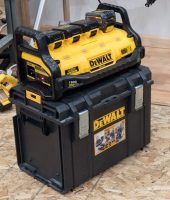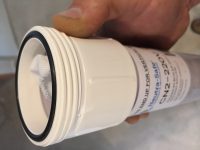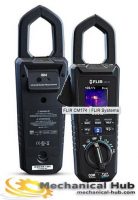The new FLEXVOLT system from Dewalt has opened up a whole new line of tools and possibilities for the pro contractor looking to get more done in less time. We’ve had a few of the FLEXVOLT tools at work in our shop and in the hands of the ProStaff team for a couple months now Read more
Industry Blogs

The new FLEXVOLT system from Dewalt has opened up a whole new line of tools and possibilities for the pro contractor looking to get more done in less time. We’ve had a few of the FLEXVOLT tools at work in our shop and in the hands of the ProStaff team for a couple months now and continue to be impressed. The latest is the DCB1800 Portable Power Station.
The power station is a combination 4-bank parallel battery charger and DC power inverter capable of providing 1800 watts continuous power at 15A with a peak power rating of 3600 watts 120v. That’s some serious power, this thing is sick.
There are a still a lot of tools on the job that haven’t lent well to cordless technology yet. Core drills, large demo hammers, compressors and various saws. Add to that the many contractors still using corded tools where upgrades either haven’t been in the budget or replacement of a perfectly good tool is unwarranted and you’ve got the need for portable power.
The DCB1800 power station is a portable generator running off (4) 20v MAX batteries, not a gas engine so indoor use is not a problem. The inverter is silent in comparison to any other portable power solution as well making it a non-factor where noise is a obstacle to getting the job done. This is a gamechanger for those looking to knock out some punch list items at the end of the job or quickly get in and out to complete a task with a corded tool when cordless isn’t available.
I wanted to get an idea of how much power this thing has so I loaded it up with (1) FLEXVOLT 20/60v MAX pack and (3) 20v MAX batteries, all new and fully charged and plugged my DW734 thickness planer in to it. I ran (14) 2×8 Fir boards thru the planer before losing power supply. The low power indicator lights started flashing after 10 boards, giving me four more complete before shutting down. That’s 112 feet of planing 2×8’s! I’d imagine ripping some plywood for backing or chipping with a rotary hammer for 20-30 minutes is within reach with a power supply like that. I’ll be putting this to the test on the job soon so stay tuned, for now check out video proof of my test:
https://youtu.be/bHT9eJi9cvM

We hear the phrase that water is the universal solvent. Why? So many materials dissolve in water due to its unique molecular structure. So it does not seem like a fluid to be used in a hydronic heating system made of many different materials. Water does have many advantages as a heat transfer material. It Read more
We hear the phrase that water is the universal solvent. Why? So many materials dissolve in water due to its unique molecular structure. So it does not seem like a fluid to be used in a hydronic heating system made of many different materials. Water does have many advantages as a heat transfer material. It is cheap, safe, easily acquired, has a wide liquid temperature range, and is generally non-toxic.
With water coming from so many different sources worldwide, it can contain many different minerals. It is the wide combination of these minerals that water gathers as it flows through our aquifers that needs attention.
Many of the common minerals found in water will cause issues in hydronic systems. The hardness of the water, and minerals that fall from solution, are the most common concerns. As the minerals precipitate out, they can stick to and coat the surfaces of our boiler heat exchangers, for example. This coating forms until enough build-up reduces the heat exchange and the metal of the heat exchanger breaks down. A classic example is what you see when you drain an old tank-style water heater. Some of the material that can be found in tap water cause further concern…like chlorides.
Boiler and tank manufacturers are now listing the most harmful minerals as well as acceptable levels. Calcium, magnesium, chlorides, and sulfates are commonly listed. The ph level is also required to fall within a range, something like 6.6 and 8.5 according to one boiler specification.
Failure to maintain the proper water chemistry can cause loss of efficiency, noise, wear, premature failure, and most important to the consumer, lack of warranty.
So the industry needs to first get some training on what to look for, how to measure levels, and what to do with water that does not meet the quality required to assure warranty coverage.
Most agree that starting with good quality water is one key. It is possible that the water in your town is of sufficient quality. But if you are not testing, you are guessing. Know also that water quality in an area can vary season to season. One of the most noticeable changes in water quality can be linked to the road deicing chemicals used. Back in the day, rock salt, maybe blended with sand, was the go to deicer. Nowadays chloride blends are being used in may states. Chlorides have a wider melt range, and can be applied as a liquid. They often get applied before a snowstorm, or icing condition as a proactive measure.
Guess where these chlorides end up? In our water supplies, via lakes, rivers, and even well sources. Many water sources have been seeing a spike in chlorides. States like Wisconsin and Minnesota have been monitoring this carefully as the aquatic life in their thousands of lakes and rivers are being affected by the elevated chlorides, as well as the flora and fauna.
There is a fairly simple fix for water that is not of sufficient quality for use in hydronic systems. Both deionizing and chemical treatments are available to help bring water back to a hydronic-friendly heat transfer fluid.
Flush your systems. Consider a hydronic detergent to rid the system of oil, flux, dirt, etc. Test the water for the final fill, and treat as required, or haul quality water from another source.
You will be hearing more about boiler water quality as manufacturers of boilers, tanks, pumps, valves, etc. start reexamining warranty returns that have been compromised by fluid quality. It will be a tough conversation to have with a home or building owner if an expensive component fails prematurely due to fluid quality and the warranty is refused.
 Hot Rod is currently the training and education manager for Caleffi North America. He owned his own contracting company, Show Me Radiant Heat & Solar, Rogersville, Mo., having been a plumbing and heating contractor since 1978.
Hot Rod is currently the training and education manager for Caleffi North America. He owned his own contracting company, Show Me Radiant Heat & Solar, Rogersville, Mo., having been a plumbing and heating contractor since 1978.

Job Scope: Remote lake home with hydronics ceilings & panel radiators Dual-fuel system (Electric boiler w/ High efficiency back-up) Septic waste system for onsite waste removal The majority of new or replacement heating system installations include high efficiency condensing appliances. The condensate is produced as a product of the appliance operation; in this case the Read more
Job Scope:
- Remote lake home with hydronics ceilings & panel radiators
- Dual-fuel system (Electric boiler w/ High efficiency back-up)
- Septic waste system for onsite waste removal
The majority of new or replacement heating system installations include high efficiency condensing appliances. The condensate is produced as a product of the appliance operation; in this case the boiler extracts additional btu’s contained in the water vapor of the flue gasses. When the flue gas temperatures drop below the approximate dew point of 135°F the water vapor condenses and the resulting liquid is acidic. This acidic condensate liquid requires treatment to avoid damage to piping systems, septic systems, treatment facilities and other items it may come in contact with. Many municipalities now require condensate treatment with all new installs and permitted replacements.
Read more about condensate neutralizing here:
The importance of neutralizing condensate produced by high efficiency gas fired appliances
A recent family lake home project gave me the opportunity to install the Neutra-Safe clear tube style neutralizer model CN-220V. You may be familiar already with neutralizers but I assure you this one is different than others I have installed in the past. The expected wholesale cost of the kit should be approximately $50-60.
Product Specs:
- Capacity – 220,000 BTU/hr
- Connection/fitting size – ½” MPT / ¾” PVC Female Solvent Weld
- Tube body size – 2”
- Integral unions w/ O-ring seal (for servicing)
- Stainless Steel screen on inlet to prevent plugging of unit
- Media (included) – Calcite & magnesium oxide pellets (bagged/contained)
The CN2-220V is an “up-flow” or vertical neutralizer. This means the condensate enters the neutralizer at the bottom of the 2” clear plastic body, as the condensate passes thru the filter media it exits out the top center where piping is routed to a nearby drain or pump. This design assures all condensate passes thru the media where other designs do not require the entire media area to be flooded; thus allowing for small flow rates to pass thru a neutralizer without fully filtering and neutralizing above the typical PH of 2-4. The photo below shows a typical installation with the [included] mounting hardware and drain tubing routing.

Body & Media pictured here. Media shipped and installed bagged to prevent media materials clogging drain tubing.
I’ve installed multiple brands of neutralizers in the past, the CN2-220V is the first to include all the necessary mounting hardware, fittings for initial tubing connections and bagged media for ease of installation, this being all in one package negating the need to source additional parts to finish the install. Of course drain tubing is field supplied, along with the needed fittings for full installation.
 The Neutra-Safe tube style neutralizers feature integral unions with O-ring seals that greatly simplify removal for service and recharging. Un-threading a lock ring on either end of the unit allows the main body to be removed without disturbing the drain line. Replacement O-rings are included with tube style recharge kits and all tube style neutralizers are available with a snap-in mounting clamp option.
The Neutra-Safe tube style neutralizers feature integral unions with O-ring seals that greatly simplify removal for service and recharging. Un-threading a lock ring on either end of the unit allows the main body to be removed without disturbing the drain line. Replacement O-rings are included with tube style recharge kits and all tube style neutralizers are available with a snap-in mounting clamp option.
The media replacement schedule is one year, they’ve even included a model number sticker on the tube where you can write the date of installation/replacement for reference. You should expect the wholesale cost of media replacement, which includes the o-rings and bagged media, to be approximately $25-30.

Being that this installation was the first time I had held the product in my hands I can say it did take me a few minutes to figure out how the included fittings and tube were to be assembled but the included instructions made for a simple install.
I’ve seen many times the effects of acidic condensate can have on piping systems, floor drains and concrete surfaces and that is why I include a neutralizer with all my high efficiency installs. Furthermore, many of the municipalities in my area are requiring them for both new installs and replacements.

TOOL: FLIR CM174 Imaging 600A AC/DC Clamp Meter With IGM (Infrared Guided Measurement) Mechanical Hub asked me to test out the FLIR CM174 Clamp Meter with the integrated IR Camera. I was excited yet skeptical to try out a new meter. In my line of electrical work I have my ‘go to’ meters and current Read more
TOOL: FLIR CM174 Imaging 600A AC/DC Clamp Meter With IGM (Infrared Guided Measurement)
Mechanical Hub asked me to test out the FLIR CM174 Clamp Meter with the integrated IR Camera. I was excited yet skeptical to try out a new meter. In my line of electrical work I have my ‘go to’ meters and current clamps that I know every in and out of. These have shared the same long days, weekends, overnights, and holiday emergency calls, so why look at product other than what I’ve carried for years? Well after I familiarized myself with the FLIR CM174, I was impressed by the added functionality that this meter provided.
Let’s be honest, in the electrical world there is voltage and current and you don’t need much of a complex device to tell you what these readings are; however, I didn’t realize what all I was missing without FLIR’s IGM technology (Infrared Guided Measurement). The IR function of this compact meter gave me an advantage and more importantly a safety aspect to my job that was not their previously. Not only can I easily troubleshoot hot spots and imminent failures with this meter, but when going through my procedures to test for ‘zero’ voltage or absence of voltage, I am also able to take a look at the thermal properties of the equipment. The old mentality is that I need to get to work and get this job done as quick as possible, so I only care about voltage – am I going to get shocked or not. Getting hit by a stiff 480V in the morning is not how I like to start my day, but the reality is I’m stuck in a time crunch and the customer is standing behind me tapping his feet because his plant is shut down and costing him big dollars every second it is down. So I hurry up and grab my ‘new’ meter, and as expected, the voltage is zero, but what about the temperature? Do I really have time to check this, and why would I care to even look at this, I have never done this in the past. So I have the meter in my hand and it is only 1 quick click away from telling me the temperature. To my surprise there is a section of the equipment that was extremely hot due to a loose connection. My heart takes off and I get a little clammy thinking about how bad I could have been burnt when I would have grabbed onto the equipment to get this repair completed while trying to get the customer back online. 
The silent killer, known as electricity, is not the only silent danger that I should be worried about. I thank the FLIR CM174 for identifying other safety aspects of my job and preventing me from being injured. The safety aspect alone is worth having the meter, but the ability to troubleshoot using the IR functionality of this meter is a huge step above what the industry is used to. At the end of day, the customer has the lights back on and was thoroughly impressed by the equipment not only to solve their problems, but to identify and resolve other pending issues that were not identified before. This customer is now loyal to us and continues to use us for their service needs.
Click the ProStaff logo below to enter this month’s giveaway

Zone valves and indirect water heaters? I’m guessing most guys would rather drink warm beer than install an indirect with a zone valve. Why? The answers given are usually the standard ones given about zone valves in general, slow recovery, not enough flow, bad practice, no DHW if circulator pump fails but in reality the Read more
 Zone valves and indirect water heaters? I’m guessing most guys would rather drink warm beer than install an indirect with a zone valve. Why? The answers given are usually the standard ones given about zone valves in general, slow recovery, not enough flow, bad practice, no DHW if circulator pump fails but in reality the real answer is the same as it most often is in this industry, “We always do it that way” I felt that way myself, but over the course of years I ran across many jobs with a zone valve on the indirect and, by and large, the customers weren’t complaining. I assumed they thought the reduced performance was normal so I asked them and they proceeded to tell me how long their teenage daughters were in the shower and how happy they were with their decision to buy an indirect. How can this be? After doing a little research, I decided to switch sides!
Zone valves and indirect water heaters? I’m guessing most guys would rather drink warm beer than install an indirect with a zone valve. Why? The answers given are usually the standard ones given about zone valves in general, slow recovery, not enough flow, bad practice, no DHW if circulator pump fails but in reality the real answer is the same as it most often is in this industry, “We always do it that way” I felt that way myself, but over the course of years I ran across many jobs with a zone valve on the indirect and, by and large, the customers weren’t complaining. I assumed they thought the reduced performance was normal so I asked them and they proceeded to tell me how long their teenage daughters were in the shower and how happy they were with their decision to buy an indirect. How can this be? After doing a little research, I decided to switch sides!
We install indirects with zone valves quite frequently and never have an issue. It’s a bit of a long explanation involving a fair bit of math but bear with me. Let’s assume we are installing a new boiler with an indirect utilizing a zone valve. How do you size a pump for an indirect currently? To do it correctly you need to know the head loss of the piping, fittings and heat exchanger as well as the desired flow rate and then choose a pump that will meet the GPM requirements at the head loss of the system. How many people do that? Usually not too many! Most people will choose a 007 or to be on “safe side” a 3-speed pump so they can turn it up. If a pump manufacturer came out with a pump that had four speeds they could be like Spinal Tap!
For an example, lets use a popular 32-gallon indirect with a head loss of 1.9ft and a recommended flow rate of 8 GPM to achieve it’s rated first hour output of 165GPH at a temp rise of 77 F assuming a boiler temperature of 180F. What’s the head loss of the piping? The short formula which works pretty well is as follows.
Total Linear Length x .06 = ft of head
There is approximately 4 feet of head per 100 feet of pipe run, 50% is added to account for fittings which gives us .06. But what about higher resistance devices installed in the piping, like flow valves and zone valves? These have to be accounted for separately and are rated by Cv. What the heck is Cv?
The Cv rating represents that amount of flow needed in order to create a pressure drop of 1PSI, or 2.31 feet of head, across a component like a valve. How do you convert Cv to feet of head? More math, unfortunately!
(Flow in GPM divided by Cv)2 x 2.31 = head loss
Lets use a zone valve with a Cv of 8 in our hypothetical installation, the higher the Cv number the less resistance to flow.
(8 divided by 8) squared = 1 x 2.31 = 2.31 ft/head loss for zone valve
What about the piping? Lets assume we have 25 feet of piping from the boiler to indirect and back. Just a little more math. 25 times .06= 1.2 ft/head
Lets add it all up!
Indirect- 1.9ft
Piping- 1.2 ft
Zone valve 2.3 ft for a total of 5.34 ft/head at 8 GPM. What size pump do we use? Taking a look at a pump curve chart for a circulator that will provide 8 GPM at 5.5 ft/head, a 005 is pretty close but a 007 is a better choice.
What if we used a circulator and weighted flow valve on this job? Everything else would stay the same all we would have to do is swap out the head loss of the zone valve for the flow valve. What is the Cv of a weighted flow valve? A 1” NPT flow valve has a Cv of 6.7, the same valve in sweat is 7.7 Cv. Remember, the higher the Cv the less resistance. The installation with a flow valve actually has a greater head loss than the zone valve job? Yes, it does!
This is how we can use zone valves on indirect water heaters with no homeowner complaints The caveat when using a zone valve on an indirect is domestic priority. Without priority you need to size the circulator for the zone with the largest head loss, which may not be the indirect zone and the flow rate for the all the zones combined.
 Robert C. OBrien is the owner of Technical Heating Co. LLC in Mt. Sinai, NY. Robert serves as the Vice President of the national OESP chapter. See more from Robert in his blog “Boiler Sizing & Indirect Water Heaters” “Heat Loss Calculation on every residential boiler replacement?” & “Converting from Oil to Natural Gas.”
Robert C. OBrien is the owner of Technical Heating Co. LLC in Mt. Sinai, NY. Robert serves as the Vice President of the national OESP chapter. See more from Robert in his blog “Boiler Sizing & Indirect Water Heaters” “Heat Loss Calculation on every residential boiler replacement?” & “Converting from Oil to Natural Gas.”



